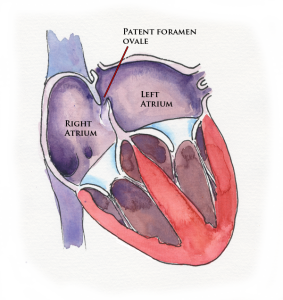Patent Foramen Ovale | The Hidden Danger

ISSN 1059-651 Volume 28 Number 3
An Altitude and Depth Perspective
By Jeff Toorish NREMT-P, WEMT, GeoMEDIC, I/C –A SOLO Instructor
The foramen ovale is a small orifice located in the atrial septum. Its purpose is to enhance the circulation of blood during fetal development. A fetus in the womb does not use its  own lungs to oxygenate blood because its lungs are not yet developed having had no exposure to air. Instead the fetus relies on oxygen from the mother via the umbilical cord. For this reason, blood must travel directly from the right atrium of the fetal heart to the left atrium of the fetal heart through the foramen ovale, bypassing a trip to the right ventricle and, ultimately, the undeveloped fetal lungs.
own lungs to oxygenate blood because its lungs are not yet developed having had no exposure to air. Instead the fetus relies on oxygen from the mother via the umbilical cord. For this reason, blood must travel directly from the right atrium of the fetal heart to the left atrium of the fetal heart through the foramen ovale, bypassing a trip to the right ventricle and, ultimately, the undeveloped fetal lungs.
Increased blood pressure at birth normally closes the foramen ovale and it normally becomes permanently sealed during the first months of life in most people. If this hole in the atrial septum does not close properly it retains patency and is called a patent foramen ovale (PFO), which normally presents as a flap-valve that only opens during certain conditions. If the pressure is great enough, oxygen poor blood will travel directly from the right atrium of the heart to the left atrium. This is also a gateway for clots to travel more easily through the heart.
Approximately 25 percent of people in the general population have PFO, although many will never know it. That number increases in specific population cohorts and PFO is linked to stroke, seizure, migraine headaches, increased decompression sickness in divers, and increased diagnoses of HAPE in climbers. Remarkably, many front line and pre-hospital providers have never heard of PFO and even in hospital settings it is often overlooked. In this report I will explore these hidden dangers and its potential impact in the pre-hospital setting.
